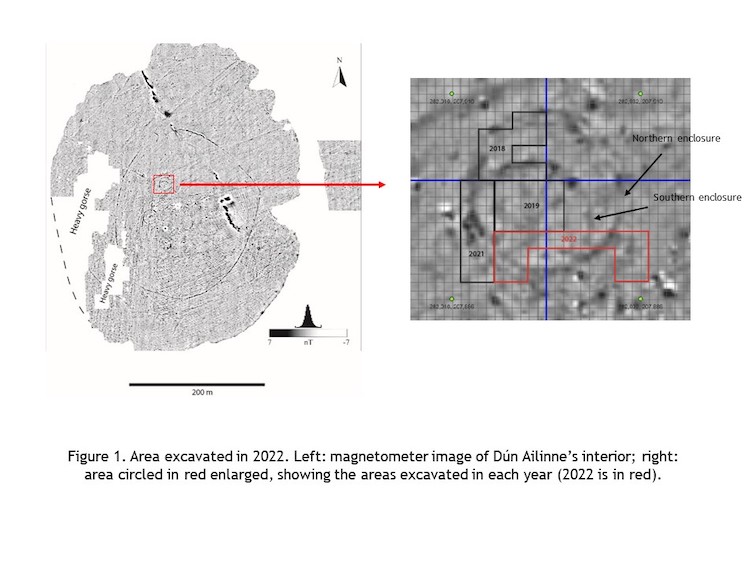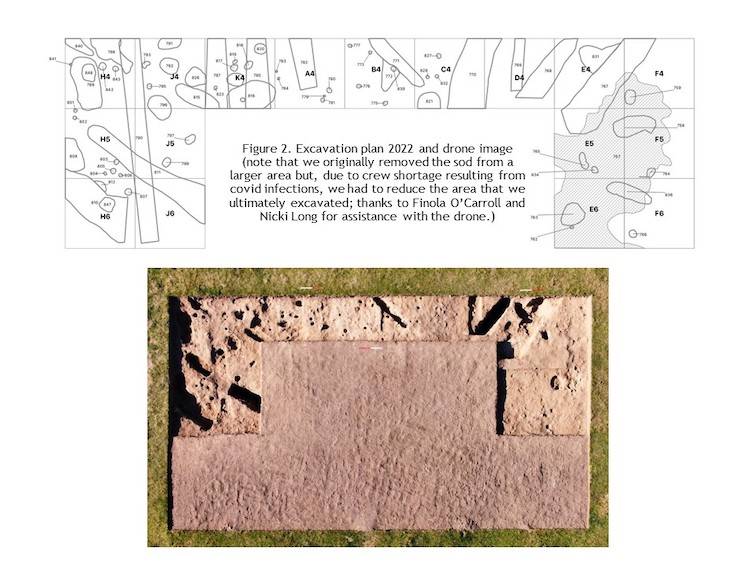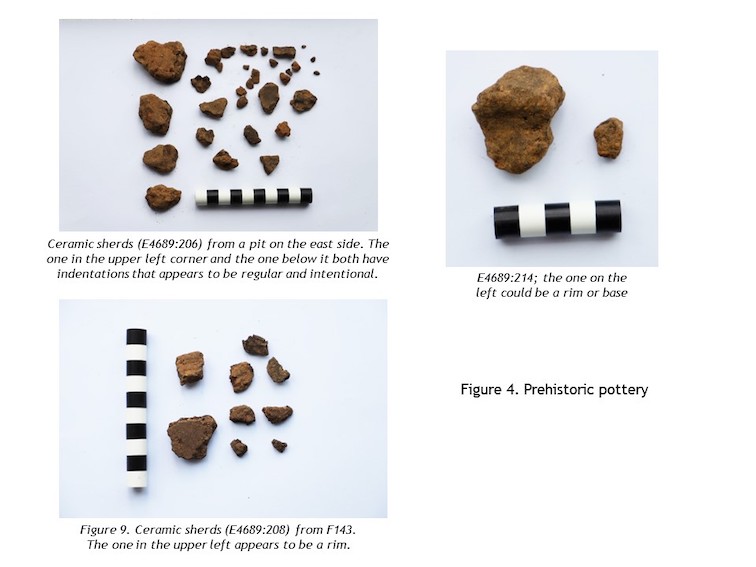County: Kildare Site name: Dún Ailinne
Sites and Monuments Record No.: KD028-038 (including -038001 through -038006) Licence number: E0004689 (C000748)
Author: Susan A. Johnston
Site type: Iron Age royal site
Period/Dating: Iron Age (800 BC-AD 339)
ITM: E 681962m, N 707912m
Latitude, Longitude (decimal degrees): 53.115462, -6.775661
A four-week field school excavation was carried out at Dún Ailinne, Co. Kildare, from June 20-July 15, 2022, to continue the excavation of two ditched enclosures identified through a magnetometer survey (2006-2008). Both are circular and appear to intersect, the one to the north slightly larger than the one to the south (18m diameter versus 14m diameter respectively). They are located within a large enclosure that rings the summit of the hill (identified through magnetometer survey and explored through excavation in 2016) but are about 50m to the north-northwest of the Iron Age timber structures identified in excavations from the 1960s and 1970s.
In 2022 we extended the sections of these enclosures excavated in 2021 to the east (Figure 1). Our initial goal was to excavate the entire area between the east and west sides of this cutting, but, due to issues resulting from Covid infections, we instead focused on this inverted U shape, bridging both sides of the northern enclosure and extending the excavated areas to the south on both east and west sides. We excavated a total of 70 archaeological features, including the inner and outer ditches of the double-ditched northern enclosure (Figure 2). As seen previously, the inner ditch was deeper than the outer ditch, but unlike sections excavated in previous years, both ditches were cut into bedrock. The shallow recut of the inner ditch, noted in 2021, was also encountered in this season, ranging in thickness from 0.1-0.18m and generally U-shaped. In addition to the enclosures, we identified a series of pits (16, 4 of them uncertain), post-holes (16, 3 of them uncertain), stake-holes (23, 6 of them uncertain), and linear features (4). These features were almost all in the north and west parts of the cutting. Among the stake- and post-holes, a few formed patterns and one post-hole was cut into the outer ditch of the northern enclosure, but most were scattered in no obvious order. Pits were also similarly scattered; they ranged in size from 0.2-0.3m to over a meter in diameter and averaged about 0.4m in depth. Among the linear features, one appears to be a slot trench, extending for 1.72m from the north wall of the cutting and ending in a rounded terminus. Its base was cut into bedrock and it was very uneven. This feature is likely associated with two lines of stake-holes, one running alongside it on its south-west side and the other extending at a right angle from its terminus to the northeast. Five plough furrows were also identified and excavated. All ran essentially north-south, a pattern seen in previous excavations in this part of Dún Ailinne. Finally, on the east side of the cutting there was a spread of material covering much of the area. It was very irregular and was generally only a few centimeters thick (though it varied). It was composed of dense, yellow-brown clay. In places it contained darker, ashy lenses mixed with charcoal that at times were fairly concentrated. In some places, this ashy material seemed to underlie the clay spread while in others it was more mixed with it.
As is typical at Dún Ailinne, few artifacts were recovered. In addition to several small lithics and some burned bone fragments (probably non-human), two stone axe heads (Figure 3) and a number of prehistoric ceramic sherds (Figure 4) were also recovered. One of the axe heads (E4689:212), from the charcoal-rich layer associated with the clay spread, was largely intact. It is 165mm in length, 78mm wide and 46mm thick. Its cutting edge is well smoothed and has very slight use damage; the butt appears to be broken. Unlike the layer from which it came, the axe head is unburned. The second axe head, E4689:218, is only a fragment, about half of the original object. It appears to be the same material as E4689:212 but it was clearly heavily used. It was found by a student (Elena Mantilla) lying on the surface near the modern entrance gate to Dún Ailinne, inside the gate and so inside the bank and ditch that surround the interior.
Also likely Neolithic in date are the ceramic sherds recovered from four contexts, three of them relatively close to each other. More than thirty sherds (numbered E4689:206) were recovered from a pit on the east side of the cutting. Most are small but several are more than 10mm in length; the largest is 47mm long, 39mm wide and 12mm thick. The fabric is soft and contains some small grit; the interior surface is blackened and the exterior is reddened. While they are highly eroded, the vessel they come from may have been decorated—two of them have several indentations on the exterior surface that appear intentional and regular. Given the similarity in fabric, the sherds may all be from the same vessel. E4689:208 was given to ten sherds recovered from an oval depression cut into the clay spread. The largest is 34mm long, 31mm wide and 9mm thick. All are eroded and most are a uniform colour (medium brown), though several of the smallest are reddened on the exterior and blackened on the interior. The fabric is fairly soft and contains considerable grit. One sherd appears to be a rim and has some lines parallel to the rim that may be decoration. An additional six sherds (E4689:209), all small, were recovered from the burned material associated with the clay spread. Finally, two sherds (E4689:214) came from a possible pit or post-hole on the west side of the cutting. One was larger than the other (40mm long, 35mm wide and 16mm thick) but both had extremely soft reddish fabric with virtually no grit. The larger sherd is somewhat irregular in shape; it could be an eroded rim from a sharply everted vessel or from the flat base of a thick-walled vessel. All artefacts and samples are now in the National Museum.




14111 Westholme Ct., Bowie, MD, 20715 USA